Condo Lease Agreement
A condominium can be the perfect solution to a simpler life if you’re open to downsizing. It can also be a stepping stone for those who are taking their first step toward having their first home.
A condo is a unit or room in a building that shares common areas with other people, much like a hotel. Renting a condo is very similar to a residential lease. However, in a condo rental agreement, the tenant or lessee is subjected to association fees, typically used for building maintenance or improving its facilities.
Looking for a condo lease agreement? This article will guide you through creating a comprehensive lease for your condominium. We’ve got you covered, from understanding critical elements to navigating legal considerations.
Understanding a Condo Lease Agreement
A condo lease agreement is a specific rental contract detailing the terms for occupying a condominium unit. It offers clear guidelines and protections for both tenant and landlord, covering the unique aspects of communal living and shared responsibilities set by the condominium association. Knowing these details can prevent misunderstandings and promote a harmonious tenancy.
Here are the different types of condominium rentals:
- Land lease condo—In some cases, buildings are owned by the association, but the land is someone else’s property (commonly the government). When this happens, a condominium association faces uncertainty. When the land lease ends, some associations merely raise the association fees. In worst-case scenarios, the association is dissolved and replaced by new management. If condominium owners have a deed, there is nothing to worry about as they get to keep their units. A change in management will be a hassle, though. If the building is under a land lease, checking when the term ends before signing into a lease agreement is essential.
- Leasehold condo—In this condominium rental agreement, an owner also becomes the lessee. Just like a lease-to-own agreement or mortgage, the owner continually pays for space. In a sense, they own part of the building. However, the association can kick them out once they stop paying, forfeiting their previous payments. Leasehold condominiums are also commonly under a land lease.
- Freehold condo—On the opposite pole of the condominium lease system, a real estate freehold is similar to buying a residential home, where you own the land and the house itself. In a freehold condo, the owner owns a piece of the land where the building resides and, therefore, doesn’t face the uncertainty of management problems or the raising of the rent. Unfortunately, a freehold lease significantly costs more than a leasehold.
- Life lease condo—Rather than a “type of lease,” a life lease can be considered a “marketing strategy.” The building often only appeals to specific demographics like seniors or small families with children. As the title implies, life leases support a person’s lifestyle through facilities and other services.
A comprehensive condo lease agreement should clearly identify the landlord and tenant, specify the rental amount, lease duration, and deposit details. These elements are crucial for clarity and legal binding. The binding contract should also include specific property details, tenancy duration, and each party’s responsibilities.
A unique aspect of a condo lease agreement is the inclusion of common charges and fees. A tenant understands that these additional rent and fees will cover the maintenance and repair of common areas or specific amenities. It is also important to disclose any additional fees for services like maintenance, which might not be covered by the monthly rent.
Common charges can include costs for amenities like parking, gym facilities, or swimming pools. Disclosing any additional fees for services like maintenance, which might not be covered by the monthly rent, is also important. Transparent disclosure helps tenants fully understand their financial obligations, ensuring no hidden costs.
Applicable Laws
Laws governing condo lease agreements vary significantly between jurisdictions, impacting terms and tenant rights. Aligning lease terms with local laws ensures legal enforceability. For instance, the eviction process requires landlords to provide tenants with days written notice, ranging from 3 to 30 days depending on local regulations. Adhering to these laws protects both parties and ensures compliance.
Understanding the legal framework, including statutory laws and case law, helps landlords and tenants navigate their rights and responsibilities effectively. This knowledge prevents legal disputes and ensures a smooth tenancy.
Binding Contract
A condo lease agreement is a legally binding contract outlining the terms for occupying a condo, focusing on shared property ownership. Clear terms and mutual agreement, including signatures, make the lease binding. This agreement defines the rights and duties of both landlord and tenant, with breaches carrying serious consequences.
Once signed by both parties, the lease becomes a binding contract, establishing their rights and obligations. This legal document provides a framework for resolving disputes and ensures adherence to the agreed terms.
Security Deposit and Monthly Rent
Financial obligations under a condo lease typically involve a security deposit and monthly rent payment. Understanding these payment rules is crucial for successful rental property management.
This section covers setting the right monthly rent and handling security deposits effectively.
Setting the Monthly Rent
When determining rental prices, landlords often charge between 0.8% to 1.1% of the property’s market value. Considering local rental rates ensures the proposed rent is competitive and appealing to potential tenants. Factors like a rental market analysis and local rent control laws are crucial for setting the right price.
Researching local rental prices for similar properties and understanding peak demand periods, typically in spring and summer, helps landlords set an appropriate rent level. Specifying the rent amount, due dates, and payment methods in the rental application and lease agreement ensures clarity and avoids disputes.
Handling the Security Deposit
Collecting a security deposit, typically equal to one month’s rent, is common practice. Many jurisdictions require these deposits to be held in a separate, often interest-bearing, account to protect tenant funds. Maintaining transparency and accountability by keeping these funds separate from personal accounts is best practice.
Landlords must return security deposits after inspecting the property, deducting only for actual damages, not normal wear and tear. Some states mandate providing an itemized list of deductions with any remaining balance.
Tenant and Landlord Responsibilities
A well-drafted condo lease agreement clearly outlines the responsibilities of both tenant agrees and landlords, preventing disputes and ensuring a smooth tenancy.
This section will cover the specific duties each party must adhere to.
Maintenance and Repairs
Maintenance and repair responsibilities are critical components of a condo lease agreement. The lease should clearly state who is responsible for what, ensuring both parties understand their obligations. Customized leases can address specific concerns like maintenance responsibilities and pet policies, tailored to individual circumstances.
Tenants are generally responsible for damages they cause and maintaining the property in good condition. Landlords must ensure the property is habitable and address significant repairs or maintenance issues that arise.
Lease Term and Renewal
The term defines the duration in which the lessee has the legal right to use the property, crucial for both parties’ contractual obligations. This section covers the importance of clearly defining the lease term and the renewal process.
Defining the Lease Term
Clearly defining the term, including specific start and end dates, is critical to avoid misunderstandings. The start date, or commencement date, marks when the lessee begins to have access to the property, essential for determining lease liabilities.
The lease end date signifies when the lessee’s right to use the property concludes, which may change based on renewal options or early terminations. Establishing clear start and end dates helps avoid potential disputes regarding the tenancy duration.
Renewal Process
A lease renewal typically requires written notification by one party to the other, as stipulated in the lease agreement, to ensure both parties agree on the continuation of terms. Written confirmation from the tenant allows the landlord to draft a new rental agreement with updated terms.
Additional Provisions
Including additional provisions in a condo lease agreement ensures clarity around important rules and responsibilities for both parties.
Late Fee and Payment Terms
Late fees can be applied if a tenant fails to make rent payments by the due date or within the grace period outlined in the lease. Commonly, late fees are set between $10 to $50 per day, depending on local regulations and the landlord’s discretion.
Grace periods typically last from three to five days, giving tenants additional time to pay rent without incurring late fees. To be enforceable, these fees must be clearly defined in the lease agreement and comply with local laws.
Pet Policies
Pet policies are essential components of a condo lease agreement that outline what is allowed regarding pets. Adjusting the template allows landlords to incorporate specific property rules and tenant agreements related to pets. These policies might include restrictions or allowances, depending on the property’s rules, and should clearly state any additional fees or deposits required for pets.
Subletting and Guests
The intended use of the residential property, such as residential only, should be outlined in the lease to prevent any unauthorized activities. Subletting is often restricted in a condo lease agreement and usually requires prior written consent from the landlord. Guest policies may include limitations on the number of guests and the duration of their stay, ensuring that they do not disrupt the community.
Termination and Eviction
A lease may be terminated due to non-payment of rent, property damage, or illegal activities by the tenant. Understanding the grounds for termination and the eviction process is crucial for both landlords and tenants to navigate their rights and responsibilities within the lease agreement.
Grounds for Termination
Valid reasons for lease termination can include non-payment of rent, breach of lease terms, or mutual consent between the landlord and tenant. Common grounds for lease termination include lease violations, illegal activities on the property, and expiration of the term. Understanding these justifications helps both parties navigate their rights and responsibilities in the agreement.
Eviction Process
The eviction process begins when a landlord files a complaint with the court after the tenant ignores a termination notice. If the tenant fails to vacate the property following the termination notice, the landlord may proceed with legal action to evict the tenant. This process can involve a law enforcement officer physically removing a tenant if they refuse to leave after an eviction order.
Condo Lease Agreement Form Details
| Document Name | Condo Lease Agreement Form |
| Other Names | Condominium Rental Contract, Condominium Lease |
| Avg. Time to Fill Out | 12 minutes |
| # of Fillable Fields | 64 |
| Available Formats | Adobe PDF |
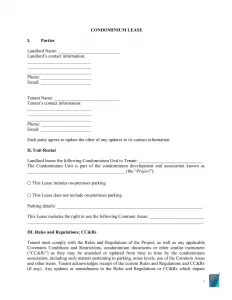
Filling Out Condominium Lease Agreements
A simple condo lease agreement protects both landlords and tenants. This legal document outlines their rights and obligations, enforceable in court if necessary. A well-drafted rental contract avoids financial penalties and legal disputes by ensuring all terms are clear and compliant.
With our free condominium lease agreement below, you don’t need to start from scratch. FormsPal formatted it like a lease form without compromising the integrity of legal rental agreement templates, making it easy to use.
Step 1 – Download the lease form below
Use any of the lease agreement template document below:
- Condo Lease Agreement Template– Open Office Format (.odt)
- Condo Lease Agreement Template – Microsoft Office Format (.docx)
If your computer asks you to install any program before you can open the lease form, download the correct program. You may have to make a free account before the download begins.
Step 2 – Add the landlord’s and tenant’s general information
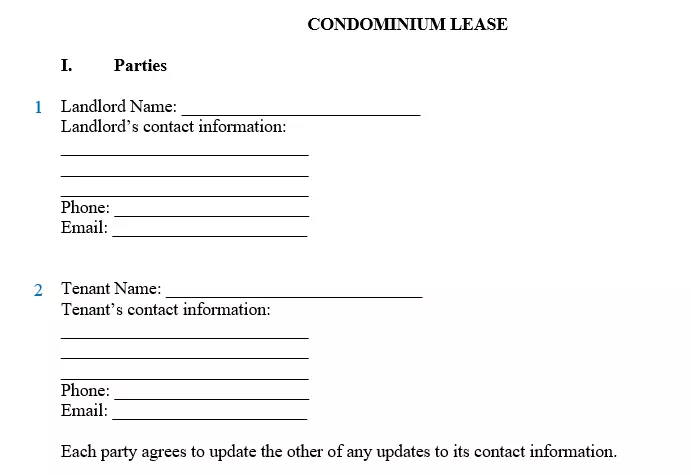
For part 1 (Landlord) and part 2 (tenant) of the template, type the following sequentially:
- Full name
- Complete address
- Landline and mobile numbers
- E-mail address
Step 3 – Describe the condominium lease terms
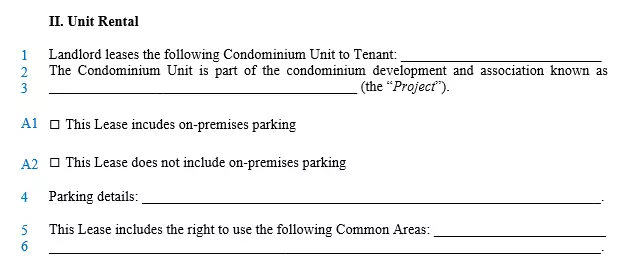
In this clause, type the following:
- 1st Line: Insert the complete address (number, floor, building number, street, area, city, county, state, zip code.)
- 3rd Line: Title of the Project (you may ask the building administrator)
- Decision point A: Select A1 if the owner owns a parking space and would like to include that under the rental. Otherwise, select A2 if this option is not included.
- 4th Line: If you selected A1, indicate the parking slot code.
- 5th to 6th Lines: Typically, residents of condominiums have access to common areas such as the pool, lounge, business centers, laundry areas, etc. List these down if applicable.
Step 4 – Read the regulations of the condominium

This provision is typically accompanied by another document that details usage of spaces, purpose of renting, terms of use, or answers for frequently asked questions.
Though the regulations of the building are not stipulated in detail inside the condominium lease agreement, these can be attached as riders to the condominium lease template. This rider must also contain necessary information like terms of use, building services, and names of important contact persons. As s rule, a tenant acknowledges that they have conducted a careful inspection, before signing the rental agreement.
Documents like these are usually made available on the association’s website.
Step 5 – Type the important dates of the lease agreement

Line 1: Indicate the beginning of the condominium lease.
Line 2: Indicate the date the lessee may occupy the space (usually the same as the first line, but can be scheduled a few days before or after the lease date).
Line 3: Indicate the date when payment should start. You may delay the first payment if the property needs repair or if a condo lease document needs to be finalized.
Step 6 – Identify the rental terms

- Decision point B: Select B1 if the condominium lease agreement is renewed every month, or B2 if there is a fixed duration for the condominium lease. If B2 applies, type the number of months on its first line.
- Line 1: Write the fee for the key replacement of the condominium unit
- Line 2: Write the fee for replacement or repair of the main gate or garage
Step 7 – Indicate the monthly rent

- Line 1: Write the monthly fee in dollars
- Line 4: Write the day in which the payment is to be paid (e.g. “6th”)
- Line 6: Tick the box if the lessee will NOT pay for any additional charges.
- Line 7: Tick the box if the lessee will pay for any additional charges. Indicate the amount in dollars.
- Line 9: If you selected line 7, list spaces or fees that the lessee will be paying for (e.g. parking, pool maintenance, association fees, etc.)
- Line 10: Indicate if the additional payment is due “monthly” or “quarterly”. The second line shows when the additional payment is due (see line 4).
- Line 11: The period when the additional payment is due (e.g. “each Month”)
It will be best if the date in Line 4 is similar to the dates in lines 10 and 11 to avoid confusion.
Step 8 – Identify the amount of the security deposit
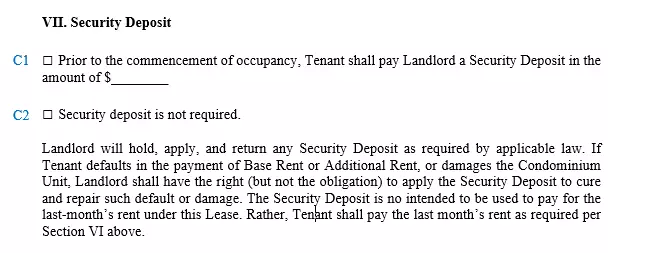
- In Decision Point C, choose C1 if there is a security deposit to be paid (usually three times of the monthly base payment at maximum). Otherwise, choose C2 if the landlord and tenant have agreed that there is no need for this.
Step 9 – Indicate which utilities will be paid during the rental
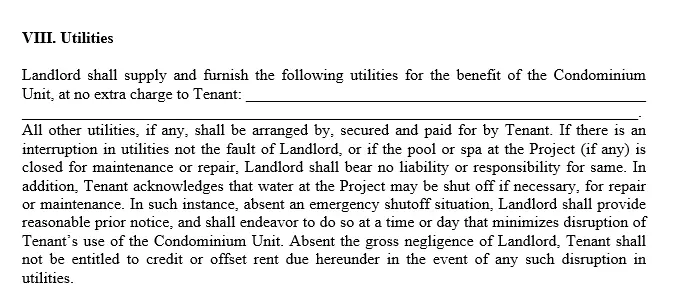
Since a building’s utilities are shared with other units, the association is typically strict with payments. As such is the case, landlords get an estimate of a tenant’s electrical and water use. Then, they can add that to the monthly base payment. However, if both agree that the utilities will be diligently paid by the tenant, this provision of the condominium lease template may be subject to modifications through an attorney.
Step 10 – Read the standard limits of use

- Section 9: Permitted Use
- Section 10: Decorating Condominium Unit; Changes to Unit
Should you need to make modifications to these condo lease agreement terms, please consult with an attorney. You may ask for assistance in adding a provision for other types of usage such as inviting family guests, business purposes, temporary events, and other circumstances.
Step 11 – Check if animals are allowed in the condominium

In most cases, ownership of pets is regulated by the association. Please refer to their terms or rules and regulations before finalizing section 11. If animals are allowed in the building, the condominium property owner may either:
- Prohibit animals (tick box D1)
- Allow certain pets and breeds (tick box D2).
- Line 1: If D2 applies, other guidelines on pet ownership may be added.
You may also want to check with your state law regarding ownership of exotic animals or ant farms, just to be sure. Remember: Both parties are liable for what happens inside their condominium units. Landlords, in particular, have obligations to resolve any issue caused by their tenants.
Step 12 – Explain the maintenance process
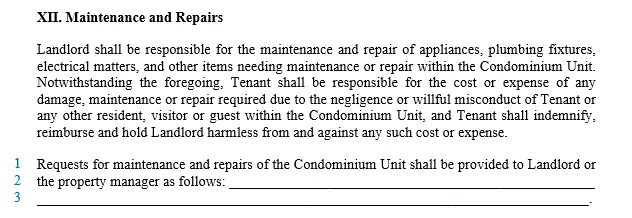
- Lines 2 to 3: Explain the process of submitting requests when under the duration of the rental. This provision ensures that while upkeep is the landlord’s responsibility, lessees must also contribute to the solution by filling out documents.
Step 13 – Determine insurance arrangements for tenants
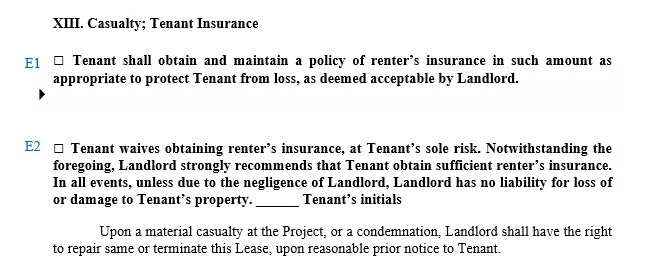
Decision point E: Choose E1 if the tenant is required to have insurance during the lease. On the other hand, the tenant may choose E2 and simply waive the property owner of any responsibility and acknowledge the risks of not being insured. On the blank provided, the tenant must write his or her initials in print.
Step 14 – Allow or prohibit subletting
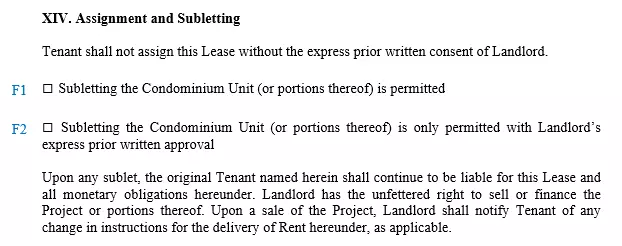
Decision point F: Tick the first box (F1) if the lessee is NOT allowed to get a roommate or allow another person to sublease the condominium on their behalf. If this is allowed, tick the second box (F2). Take note that this clause is different from having guests over. If the set-up is unclear, you may ask the help of an attorney to clarify.
Step 15 – Set default arrangements of the condominium lease agreement
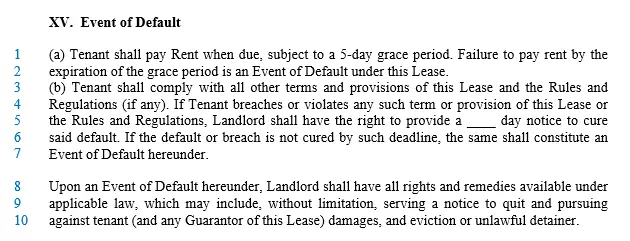
Line 5: Indicate how many days the lessee has to cure the breach of contract. Based on the terms of this provision, landlords have the right to press charges according to law or evict tenants if the breach is not cured.
Step 16 – Disclose lead-based paint warnings

Decision point G: Tick the first box (G1) if the condominium property and the building do not use lead-based paint. Tick the second box (G2) if it does. The lessee should then write his or her initials in print on the blank provided.
This disclosure is not only required, but it is also the right of the tenant to know about potential health hazards.
Step 17 – Sign the condominium lease agreement
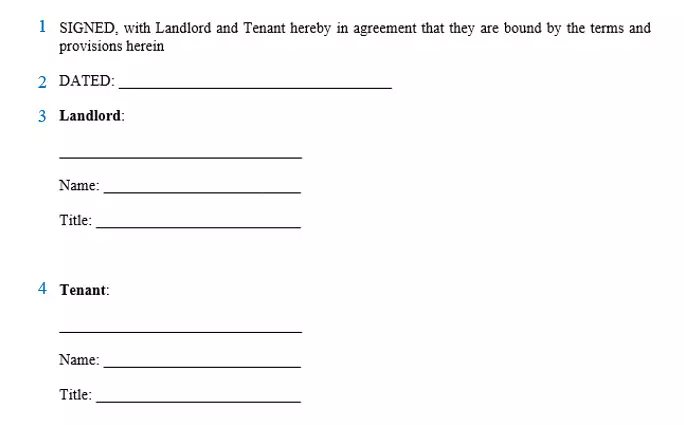
Print the condominium lease template. Afterward, write the date of contract signing (stamped or in print),
For both parts 3 and 4, write the following for the landlord and the tenant, respectively:
- Signature
- Full name
- Title
In addition to signing the last page, both parties will also need to affix their signatures on every page.
